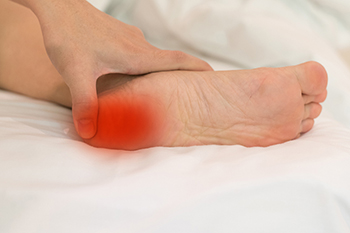
Fat pads on the bottom of your heels that provide cushioning and shock absorption are usually 1-2 centimeters thick. As you age, these fat pads can wear out and thin down to less than 1 centimeter. This condition, known medically as fat pad atrophy, can cause pain in the heel and difficulty in walking and performing daily tasks. Other factors that may contribute to fat pad atrophy include wearing inadequately supportive shoes or having rheumatoid arthritis, scleroderma, lupus, and type 2 diabetes. Fat pad atrophy can be additionally concerning for diabetic patients because this condition may contribute to the development of a foot ulcer and other complications. Podiatrists can offer a variety of treatment options for fat pad atrophy including using custom orthotics and heel cups to support the heel and offload pressure, as well as injectable fillers or fat grafting to replace the body’s natural cushioning. Make an appointment with a chiropodist who can diagnose your condition and discuss your treatment options.
Heel pain is a common problem that can be caused by a variety of injuries, medical conditions, and other factors. If you suffer from heel pain, please consult with one of the specialists from Thornhill Foot Clinic. Our chiropodists can help you maintain the health of your lower limbs and your mobility.
When it comes to heel pain, the exact location and type of pain are important to note. Some of the conditions that may cause heel pain include:
Plantar fasciitis - An inflammation of the ligament that runs along the bottom of the foot; it causes a stabbing pain under the heel that is at its worst when taking your first few steps after a long rest and while standing on your tiptoes or climbing stairs
Achilles tendonitis - An inflammation of the tendon in the back of the calf; it causes pain in the back of the heel that is at its worst after resting, as well as ankle and calf stiffness, swelling, and tenderness
Bone spurs - Bony lumps on the back of the heel bones that cause sharp pain upon first standing up; the pain becomes dull and achy over time
Heel fractures - A break or crack in the heel bone that causes pain, swelling, and difficulty walking
Retrocalcaneal bursitis - Swelling of the small, fluid-filled sac at the back of the heel bone; it causes pain, swelling, redness, and warmth in the back of the heel
Tarsal tunnel syndrome - Compression of the posterior tibial nerve which causes a pins and needles sensation in the heel, foot, and calf
Your chiropodist will be able to diagnose the underlying cause of your pain and prescribe the right treatments for you. If you have any questions, please feel free to contact our office located in . We offer the newest diagnostic and treatment technologies for all your foot care needs.




